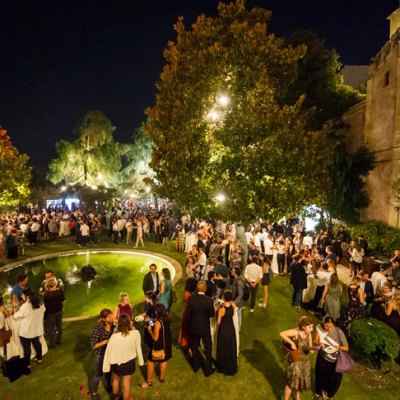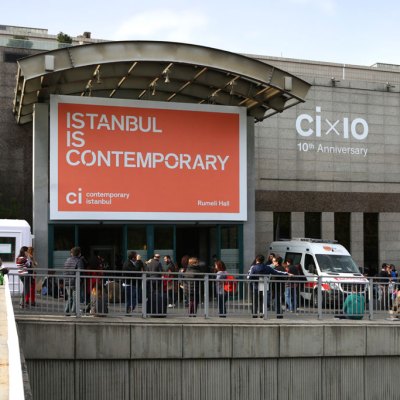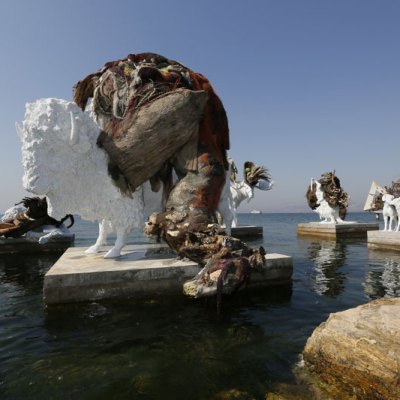This year, the 15th edition of the Istanbul Biennial takes its cue from artist duo Elmgreen & Dragset, who posed the curatorial question: What Makes a Good Neighbour? With the Biennial up and running at five sites (all within walking distance) through early November, galleries in the ‘neighbourhood’ are getting in on the action as well, bringing the city’s art scene back to life after a turbulent year of security concerns, gallery closures and uncertainty.
Installation view of ‘Kiralık, Satılık (For Rent, For Sale)’ at Protocinema. Installation view of ‘Kiralık, Satılık (For Rent, For Sale)’ at Protocinema. Courtesy Protocinema, Istanbul, New York

Opening just before the Biennial and running until 14 October, Protocinema drew early crowds to a two-exhibition installation in the Hamursuz Fırını, a disused matzo factory in the Galata neighbourhood. The itinerant art organisation, which has also held recent shows in New York, Paris and Moscow, partly chose this unconventional location for its relationship to ‘Kiralık, Satılık (For Rent, For Sale)’, a group exhibition curated by İbrahim Cansızoğlu that examines and questions Istanbul’s rapidly changing urban landscape. Spanning the ground floor, photographs, sculpture and assimilations by Ani Çelik Arevyan, Gülşah Mursaloğlu and Antonio Cosentino relate to the city’s physical and imagined history, while sounds from the Istanbul Soundscape Project bring the disappearing noises of city life inside.
Still from Interregnum (2017), Adrian Paci. Courtesy kaufmann repetto, Milan, New York, Protocinema, Istanbul, New York
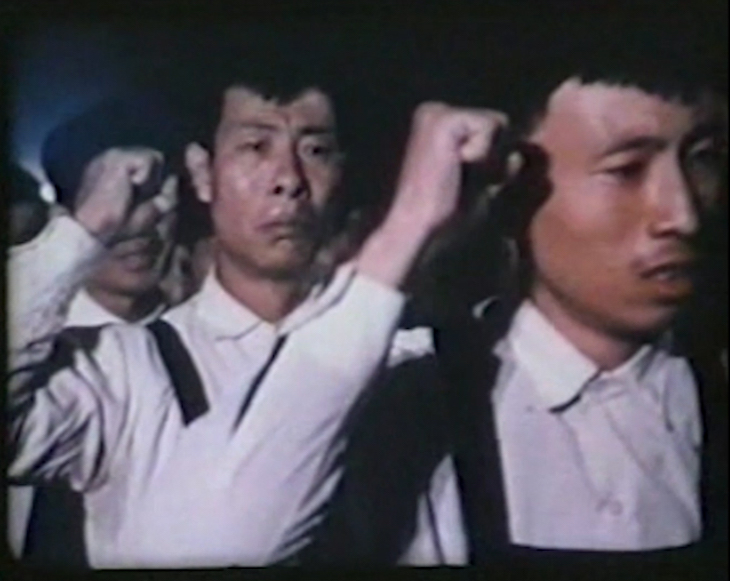
Upstairs, ideas of Istanbul’s cityscape are traded for state funereal footage in Adrian Paci’s film Interregnum, 2017. The Albanian artist scanned hours of 20th-century archival footage from across Europe and Asia, choosing to focus on the nameless faces of those grieving a lost political leader. It’s a voyeuristic reflection on grief, as performed by those who never personally knew those who they are grieving, and it oscillates between images of formal nationalistic ritual and personal despair. Both exhibitions, though very different, provide a complementary space to ruminate on Istanbul’s recent challenges, urban and otherwise.
A short walk away, SALT Galata takes a multimedia look at the complicated, often fruitful relationships between architects and their patrons. ‘Commissioner’s Exhibition’ takes place throughout the non-profit multidisciplinary research space, which is housed in the beautifully restored Ottoman Bank on Bankalar Caddesi (until 26 November). While items like architectural sketchbooks that speak to the building’s own renovation process are dotted around the interior, a trip down the marble staircase into the core exhibition space reveals an enthralling display of photographs, drawings, plans and correspondence from architectural archives housed in SALT’s research library.
METU pedestrian walkway, faculties of Architecture and Administrative Sciences in the background. SALT Research, Altuğ-Behruz Çinici Archive
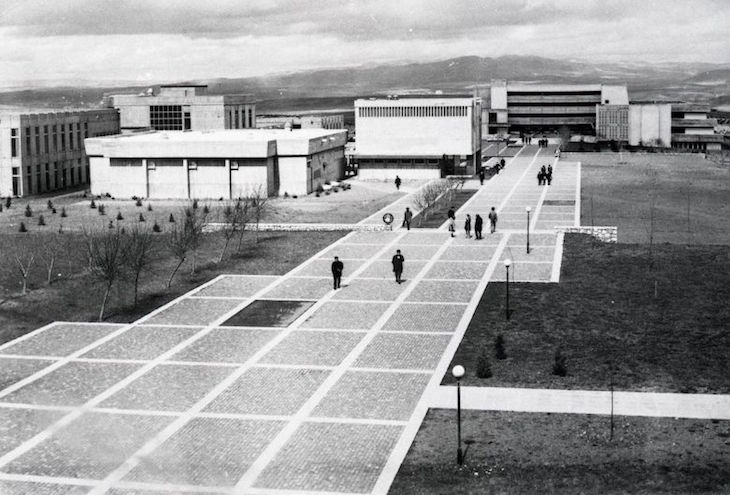
The largest and most detailed portion of the exhibition is devoted to the 1961 national design competition for the new campus of the Middle East Technical Institute. The consequential relationship between the winners, Altuğ Çinici and Behruz Çinici, and the school’s president, Kemal Kurdaş stresses the delicate balance that must be struck between both. But perhaps the most effective subject tackled is that of women patrons’ structures in Ottoman Istanbul – a new wall-sized map illustrates the under-reported role of female commissioners dating as far back as the late 1500s, illuminated by a maze of material worth getting lost in.
Over in the Cihangir neighbourhood, Turkish artist Halil Altındere has taken over the interior of the spectacularly dilapidated Sadık Pasha Mansion with a solo exhibition entitled ‘Welcome to Homeland’ organised by Pilot (until 21 October). Exhibited for the first time in Istanbul, Altındere’s multimedia installation, curated by DAS Art Projects, tackles the critical subject of the ongoing Syrian refugee crisis. The bottom floor, dedicated to his project ‘Space Refugee’, charts the life of Muhammed Ahmed Faris. After training in Russia, the Syrian astronaut made a trip into space in 1987; in 2012, Faris and his family became refugees, eventually settling in Istanbul. Central to the exhibition is Altındere’s semi-biographical video about Faris’ life, which expands into scientific musings about the possibilities of settling on Mars, a land that belongs to no one. Upstairs, Altındere’s film Homeland, featuring Syrian rapper Mohammad Abu Hajar, speaks to this continued idea of land lost through the devastation of war. The films, enhanced by installations of celebratory portraits, spacesuits and a large-scale photograph of Altındere’s imagined ‘Kofte’ Airlines for refugees, drive home his wry, effective observations about a crisis that is both local and widespread.
Installation view of ‘A Community of Lines’ at Pi Artworks. Photo: Batu Tezyuksel; courtesy Pi Artworks
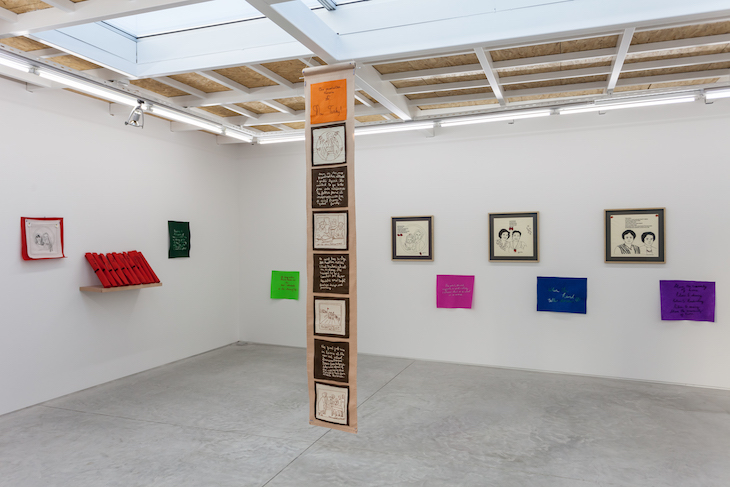
On 19 September, Pi Artworks opened their new Istanbul location with a solo show, ‘A Community of Lines’, curated by Asli Seven, devoted to the work of American-born Istanbul artist Nancy Atakan (until 21 October). Atakan’s latest pieces, rendered in needlework and felt, is family memory made physical: taking stories and photographs from the women closest to her, Atakan approaches theses exchanges by stitching them into scrolled, ribboned ‘gifts’, centrally displayed. These highly personal works are surrounded by embroidery that recalls a greater female narrative of the many ‘new’ Turkeys that recent generations have been forced to grapple with. Confronting the domestic roles allocated to the female workforce in the mid 20th century head on in her use of materials, Atakan is able to synthesise personal oral histories with greater historical and generational shifts.
Installation view of ‘A Community of Lines’ at Pi Artworks. Photo: Batu Tezyuksel; courtesy Pi Artworks

In the city centre, non-profit arts space Depo is exhibiting the work of Jerusalem-born artist Dor Guez in the second installation of his five-part project, ‘The Sick Man of Europe: The Architect’ (until 29 October). The project focuses on regional cultural histories emerging out of the collapsed Ottoman Empire, using the narratives of artists-turned-soldiers. In this iteration, curated by Yael Messer, we are presented with Kemal P., a Turkish architecture student who joined the army in the late 1930s. In a two-channel video installation, Kemal P.’s own photographs and narration depict an architecturally-focused view of the changes throughout the relatively new Republic; alongside, a hand draws the facades and monuments present in the images. The exhibition also displays Kemal P.’s personal collection of military portraits and group photos, which, when seen en masse, play with the ideas of presentation and masculinity – a collection of images that are at once nostalgic and draw forth militaristic ideas of Turkey-then, and Turkey-now.
